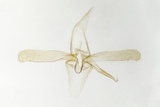Phyllonorycter maestingella (Müller, 1764) Species
Last modified: Dec. 14, 2024, 4:17 p.m.
A common and widespread species in Belgium, present in all provinces.
Details
- Classification
- Family: Gracillariidae > Subfamily: Lithocolletinae > Genus: Phyllonorycter > Species: Phyllonorycter maestingella
- Vernacular names
- Beukenvouwmot (NL), Beech midget (EN), Buchenminiermotte (DE)
- Synonyms
- Phyllonorycter faginella (Zeller, 1846)
- First mention in Belgium
- De Fré Ch. 1858. Catalogue des Microlépidoptères de la Belgique. — Annales de la Société entomologique belge 2: 45–162. On page 156 (as faginella). view page
- Status
-
Native
Distribution
Imago
Head brown; forewing ground color brown, white pattern consisting of a straight basal line, a patch near the base at dorsum, four costal and three dorsal striae, all finely edged with dark brown scales; a dark brown patch in the apical area.
Caterpillar
First instars whitish green, later on yellowish.
Mine
At first a short (max. 7 mm) blotch mine along the vein where the egg was oviposited, then growing into a long tentiform mine reaching from the main vein to the leaf margin. Some longitudinal folds close to each other. Frass is concentrated in a corner of the mine.
See also gracillariidae.net and bladmineerders.be.
Cocoon/pupa
A loose, white, silken cocoon at the opposite side of the mine than where the frass is concentrated. Pupa brown till blackish.
Bionomics
The egg is oviposited close to a vein on the underside of a leaf.
Pupation inside the silken cocoon. The species hibernates in the pupal stage, in the fallen leaf among leaf litter on the ground. The pupal skin protrudes through the mine after the emergence of the adult.
Flight periods
Two generations a year from April to early June and July–August.
Habitat
Beech forests, parks, hedge rows aligned with Fagus.














